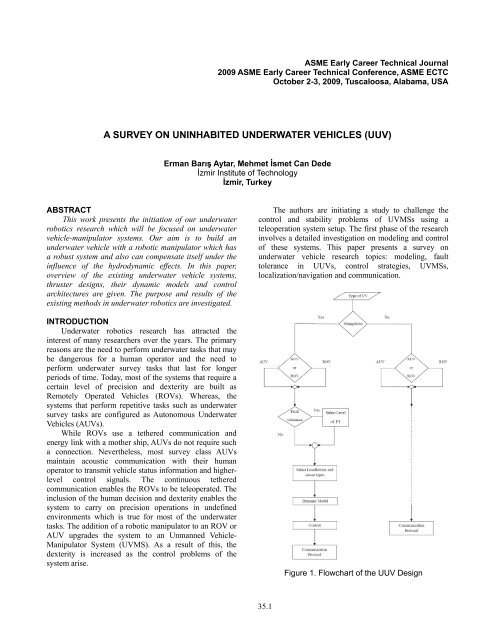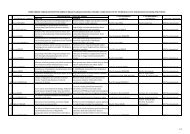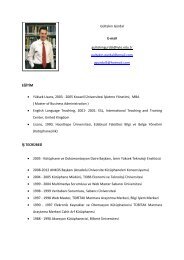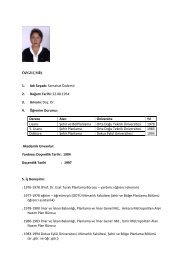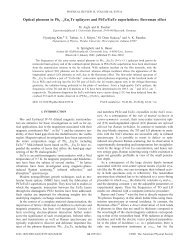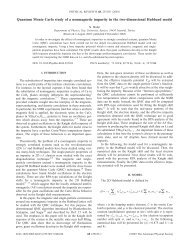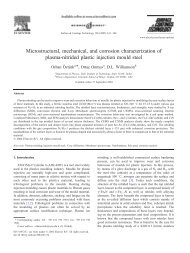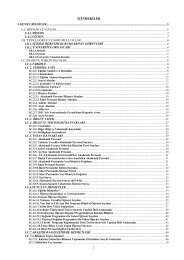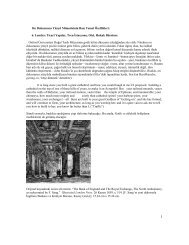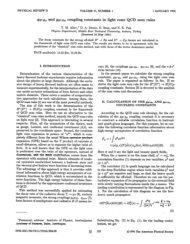A SURVEY ON UNINHABITED UNDERWATER VEHICLES (UUV)
A SURVEY ON UNINHABITED UNDERWATER VEHICLES (UUV)
A SURVEY ON UNINHABITED UNDERWATER VEHICLES (UUV)
You also want an ePaper? Increase the reach of your titles
YUMPU automatically turns print PDFs into web optimized ePapers that Google loves.
ASME Early Career Technical Journal2009 ASME Early Career Technical Conference, ASME ECTCOctober 2-3, 2009, Tuscaloosa, Alabama, USAA <strong>SURVEY</strong> <strong>ON</strong> <strong>UNINHABITED</strong> <strong>UNDERWATER</strong> <strong>VEHICLES</strong> (<strong>UUV</strong>)Erman Barış Aytar, Mehmet İsmet Can Dedeİzmir Institute of Technologyİzmir, TurkeyABSTRACTThis work presents the initiation of our underwaterrobotics research which will be focused on underwatervehicle-manipulator systems. Our aim is to build anunderwater vehicle with a robotic manipulator which hasa robust system and also can compensate itself under theinfluence of the hydrodynamic effects. In this paper,overview of the existing underwater vehicle systems,thruster designs, their dynamic models and controlarchitectures are given. The purpose and results of theexisting methods in underwater robotics are investigated.INTRODUCTI<strong>ON</strong>Underwater robotics research has attracted theinterest of many researchers over the years. The primaryreasons are the need to perform underwater tasks that maybe dangerous for a human operator and the need toperform underwater survey tasks that last for longerperiods of time. Today, most of the systems that require acertain level of precision and dexterity are built asRemotely Operated Vehicles (ROVs). Whereas, thesystems that perform repetitive tasks such as underwatersurvey tasks are configured as Autonomous UnderwaterVehicles (AUVs).While ROVs use a tethered communication andenergy link with a mother ship, AUVs do not require sucha connection. Nevertheless, most survey class AUVsmaintain acoustic communication with their humanoperator to transmit vehicle status information and higherlevelcontrol signals. The continuous tetheredcommunication enables the ROVs to be teleoperated. Theinclusion of the human decision and dexterity enables thesystem to carry on precision operations in undefinedenvironments which is true for most of the underwatertasks. The addition of a robotic manipulator to an ROV orAUV upgrades the system to an Unmanned Vehicle-Manipulator System (UVMS). As a result of this, thedexterity is increased as the control problems of thesystem arise.The authors are initiating a study to challenge thecontrol and stability problems of UVMSs using ateleoperation system setup. The first phase of the researchinvolves a detailed investigation on modeling and controlof these systems. This paper presents a survey onunderwater vehicle research topics: modeling, faulttolerance in <strong>UUV</strong>s, control strategies, UVMSs,localization/navigation and communication.Figure 1. Flowchart of the <strong>UUV</strong> Design35.1
Figure 1 outlines the design flow of an <strong>UUV</strong>.Complying with the design criteria, after the first twodecisions on inclusion of a manipulator and configuringthe system as an AUV or an ROV, the design flow is thesame for all <strong>UUV</strong>s. The designer must investigate theworking conditions of the system for possible additions offault tolerance features. After the selection of sensoryinformation, navigation and localization equipment,dynamic model of the system is developed. The dynamicmodel also includes the environment model with all thehydrodynamic effects. The ultimate task is then initiatedas the control architecture design. This design phaseinvolves simulation studies and the verification of thedeveloped controller and the system in experimentalwork. As the aim of our work is to have continuouscommunication for teleoperation, communicationprotocols and problems (time delays, data losses) remainas an open area of research.MODELINGModeling is the first phase of an <strong>UUV</strong> designregardless of selecting the <strong>UUV</strong> as and AUV or an ROV.Design criteria direct the designer whether to include arobotic manipulator to the system or not. At this point,modeling studies initiate. The modeling is investigated inthree subsections as the parameter identification, thrusterdynamics and the dynamic modeling of the whole system.IdentificationIn [1], the authors addressed the problem ofexperimental identification of finite-dimensionalnonlinear dynamical models for open-frame ROVs. Andthe results show that the development of model-basedcontrol techniques for the dynamic positioning ofunderwater robotic vehicles has been limited by the lackof experimentally validated plant models. In [2], the aimwas to demonstrate that the modeling and identification ofsmall underwater vehicles could be achieved at low cost.Identification was done in two steps, Least Squares (LS)and Extended Kalman Filter (EKF). In [3], the authorscollected the experimental data for a set of maneuverswhich were later reconstructed to give the required vehiclestate estimates. Extended Kalman filter was used for thisreconstruction. Using a stepwise regression algorithm,hydrodynamic derivative estimates were generated. Therewere significant differences between some of thehydrodynamic coefficients obtained using systemidentification and those measured using the planar motionmechanism.Thruster DynamicsA new parameter, Critical Incoming Angle (CIA), isintroduced in [4]. The incoming angle effects can bedominant while an underwater vehicle changes itsdirection, or an omni-directional vehicle carries out itstask. In [5], two improvements in the finite-dimensionalnonlinear dynamical modeling of marine thrusters isreported and tested for two conditions, axial fluid flowand using sinusoidal lift/drag curves by the authors. Thetrail data concludes that thrusters’ models utilizing bothenhancements provide a better level of accuracy in bothtransient and steady-state responses. In [6], the authorsdeveloped a nonlinear parametric model of a torquecontrolledthruster. They evaluated several compensatorsusing a hybrid simulation which combined aninstrumented thruster with a real-time mathematicalvehicle model.Dynamic ModelingKane’s method is utilized in [7] to develop an n-axisrobot arm by using. Four dynamic forces; mass, profiledrag, fluid acceleration, and buoyancy are added to theenvironment model in this work. In [8], the authors claimthat hydrodynamic forces can be large and hence have asignificant effect on the dynamic performance ofunderwater manipulation systems. Hydrodynamic forcesfor a cylindrical single-link arm are investigated in thiswork. In [9], some techniques which can be used to deriveperformance prediction and autopilot design aredescribed. These techniques are system identification andpredictive method.FAULT TOLERANCEAlthough much work has been produced on faultdetection/diagnosis, our aim is to develop systems that canconfigure a fault-tolerant system in different levels. Thus,the survey is focused on the research that provides asolution as a result of the fault detection.Fault-tolerant design of a system for the 6 degrees-offreedomODIN autonomous underwater vehicle (AUV) isdescribed in [10]. Experiments focused on detection,isolation, and accommodation of thruster and sensorfailures. In [11], the authors studied the allocation ofthruster forces of an autonomous underwater vehicleunder thruster faults. The allocation technique is based onthe generalized inverse theory and provides the minimumnorm solution to the thruster forces for a particular motiontrajectory. The proposed control law allows the AUV totrack the desired task - space trajectory with asymptoticreduction of error in case of thruster faults. In [12], theauthors presented the software and hardware architecturesof their Autonomous Underwater Vehicle Controller(AUVC). AUVC ability to detect failures and selectappropriate backup systems to achieve mission was testedin this work.C<strong>ON</strong>TROLCurrent work on the control of the underwatervehicles has been focused on actuation/thruster control,dynamic system control and, control architecture design.35.2
its environment. In [29], the authors designed a Multiinput/ Multi-output self tuning control system and theperformance of the system is evaluated.An adaptive Saturated Proportional-Derivative (SP-D) setpoint controller for AUVs is proposed in [30]. It isclaimed that the global asymptotic stability can beguaranteed even when the gravity and buoyancy force isuncertain with this type of a controller. In this work,Lyapunov’s direct method and LaSalle’s invarianceprinciple are used.A hybrid adaptive control of AUV is investigated in[31]. The authors presented the results for modified direct,indirect, and linear quadratic Gaussian adaptive control inthis study. Results concluded that the direct methodproduced the best results. In [32], the authors introduced avehicle control system that is capable of learning andadapting to changes in the vehicle dynamics andparameters. This control system is compared with aconventional linear control system in this study.In [33], the authors described a technique to localizethe vehicle through detecting known landmarks using onboardnavigation sensors, overcoming uncertainties invehicle dynamics and its operating environment.Simulations and experiments conducted in this studyindicate that the system is capable of controlling thevehicle in six DOF with high accuracy using the estimatedposition and velocity from the on-board sensor-basednavigation system. In [34], the authors presented a sixdegrees-of-freedom controller for AUVs. The authorselected the control law to be adaptive to cope with thedynamic parameters which are mostly uncertain in theunderwater environment. The proposed control law adoptsquaternion representation for attitude errors, and thusavoids representation singularities that occur when usingEuler angles description of the orientation.An adaptive control of underwater robots with sonarbasedposition measurements is presented in [35]. In thelight of the test results, the control system is shown not tonot require any prior information about the systemdynamics and yet could provide high performance in thepresence of noise and unmodelled dynamics. In [36],another adaptive control law for AUVs and ROVs isintroduced which is not using earth-fixed frame norvehicle-fixed frame. Results indicate that the use of theproposed adaptive action could significantly reduce thetracking error.In [37], the authors proposed two methods tocompensate for the model uncertainties. The first methodis an adaptive passivity-based control scheme and secondis a hybrid (adaptive and sliding) controller. In this work,the hybrid controller is simulated for the horizontalmotion of the Norwegian Experimental RemotelyOperated Vehicle (NEROV) and simulation resultsindicate a satisfactory performance. In [38], the authorsinvestigated the theory and experimental work of theAdaptive plus Disturbance Observer (ADOB) controllerfor underwater robots. They claim that this controllerwould be robust under the influence of externaldisturbance and uncertainties in the system. The result ofexperiments conducted in this study indicate that theADOB controller could be listed as promising forunderwater robots, especially for the systems with failingPID type controllers.Yuh has presented the results of recent study on theapplication of neural network to the underwater roboticvehicle system in [39]. The robustness of the system wasinvestigated against the nonlinear dynamic behavior andthe results proposed by computer simulations. Accordingto the simulation results using neural network hasincreased the autonomy of the vehicle. In [40], the authorsintroduced learning control approach to underwaterrobotic vehicle system using neural networks. Thesimulation tests result concluded that dominant vehicledynamics are varying with the vehicle velocity and effectof thruster dynamics becomes significant at low velocityin the vehicle control system. Yuh [41], has also presenteda learning control system which is using neural networksfor underwater robotic vehicles and the system is tested bysimulations. The simulation test results indicate thatcontrol system is capable of providing an acceptabletracking performance. A direct adaptive neural networkcontrol system is designed in [42]. The researchers trainedthis sytsem on-line by parallel recursive error predictionmethod and critic equation. In [43], the authors alsodescribed a neural network system which can arrange therobot dynamics and controller adaptation in parallel withrobot control. In this work, adaptability of the system isinvestigated under unknown disturbance.In [44], a neuro-fuzzy controller for autonomousunderwater vehicles (AUVs) is described. The authorsclaimed that the advantage of modified fuzzy membershipfunction-based neural networks (FMFNN) is combiningthe fuzzy logic and neural networks. Compared to othercontrol methods, the proposed FMFNN control algorithmsaid to never require any information on systems, off-linelearning procedures, and human intervention to adjustparameters. Computer simulations for this work areconducted and result indicated that the proposed FMFNNcontroller for an unknown dynamic system producesacceptable performance compared to other real-time, selftuningcontrollers. In [45], the authors present theutilization of a self adaptive neuro-fuzzy controller as afeedforward controller and in mean time PD control as afeedback controller in controlling an AUV. In [46], a newdesign for fuzzy logic controller is proposed. In the studychanges in <strong>UUV</strong> depth, regulates pitch are simulated andobserved.<strong>UNDERWATER</strong> VEHICLE-MANIPULATORSYSTEM (UVMS)The control of UVMSs can be investigated as puremotion control and interaction control architectures. In35.4
order to deploy a force-reflecting bilateral teleoperationsystem, interaction control architecture is our main area ofinterest.Dynamic Motion Control of UVMSsThe problem of redundancy resolution and motioncoordination between the vehicle and the manipulator inUVMSs are addressed in [47]. In this study, a task-priorityinverse kinematics approach to redundancy resolution ismerged with a fuzzy technique in coordination of thevehicle-arm. Researcher conducted simulation studies ona 9-dofs UVMS. In [48], a robust control scheme using amultilayer neural network with the error back propagationlearning algorithm is proposed. The proposed controller isemployed in the control of a robot manipulator operatingunder the sea which has large uncertainties such as thebuoyancy, the drag force, wave effects, currents, and theadded mass/moment of inertia. Simulation test resultsindicated that the control scheme could with theunexpected large uncertainties. In [49], the adaptivepassivity-based control scheme is formulated in anaugmented task-space where both the underwater vehicleand the end-effector have 6 degrees of freedom.A tele-robotic control system has been developed fora subsea manipulator as part of the ARM (AutomatedRemote Manipulation) project in [50]. The ability of theARM System is that it conducts tasks, previously thoughtto require divers, allows for the greater use of ROVs incurrent fields with considerable economic savings. In[51], the authors presented a new method to analyzedynamics of underwater robot manipulators. In theproposed method, hydrodynamic terms such as addedmass, drag and buoyancy in dynamics of underwaterrobots are obtained by iterative learning control and timescaletransformation. In [52], the authors developedhighly-accurate model of the hydrodynamic interactionforces, and implemented a coordinated arm/vehiclecontrol strategy. Under this model-based approach,interaction forces acting on the vehicle due to arm motionwere predicted and fed forward into the vehicle controlsystem. Using this method, vehicle station-keepingcapability was greatly enhanced. Tracking errors andsettling times for the manipulator end point were reducedsignificantly.Interaction Control of UVMSsTwo control schemes, extended hybrid control andextended impedance control, for compliant motion controlof redundant manipulators in [53]. The experimentalresults have validated the two control schemes anddemonstrated that the redundancy can be effectivelyutilized to optimize various objective functions. In [54],method of actively controlling the apparent stiffness of amanipulator end effector was presented. The approachallows the programmer to specify the three translationaland three rotational stiffness of a frame located arbitrarilyin hand coordinates. The stiffness control approach toforce control in a manipulator system has been shown tobe a useful and effective means of effecting force controlin assembly tasks.In [55], the authors presented a force control strategyfor a robot floating on the water. The control strategyreduces the number of vehicle actuators required for theforce control by utilizing the restoring force/momentapplied to the vehicle. In [56], the authors defined aproper metric in joint space. Minimal parameterization ofmotion and force controlled subspaces as wel1 as the nullmotion component is realized. With this formulation,control of both motion/force and internal motion ofredundant manipulator could be achieved utilizing a newhybrid impedance control method with inertial decouplingof each space. In [57], the authors presented a spatialimpedance control with redundancy resolution. In order toensure geometric task consistency, the rotational part ofthe stiffness is described in terms of a unit quaternion. Thedynamically consistent pseudoinverse of the manipulatorJacobian is adopted to decouple the dynamics of the endeffectormotion from the null-space motion. Redundancyis exploited to stabilize null-space joint velocities andoptimize an additional task function.LOCALIZATI<strong>ON</strong>/NAVIGATI<strong>ON</strong>Most conventional systems have to use a GPS systemto localization purposes where they have to go up to thesurface after some period of navigation. Some recentresearch activities have focused on developing newsensory systems and strategies to cancel this type of aprocedure. The following are some examples to theseefforts.At Florida Atlantic University, the researchers [58]designed and developed an enhanced inertial navigationsystem that is to be integrated into the Morpheusautonomous underwater vehicle. A complementary filterwas implemented to provide a much smoother and stableattitude estimate. The results show that the filteringperformance can be considered acceptable when the errorautocorrelation function falls within a tolerable limit. In[59], the authors introduced a new methodology for thedesign of multi-rate navigation systems for underwatervehicles. The design technique proposed borrows fromKalman filtering theory and leads naturally to multi-ratecomplementary filtering structures, the performance ofwhich can be assessed using a frequency-like domaininterpretation.In [60], the authors combined a database whichcontains sonargrammetric, terrain matching, and imageregistration information with the standard navigation withthe standard navigation instrument suite. The accuracy ofpositional estimates could be maintained over a longerduration. As a result of this adaptive calibration, it isdiscussed that it is no longer necessary to go up to thesurface to get new position from GPS. In [61], the authors35.5
provided a navigation method of an (AUV) for photomosaicing of shallow vent areas where bubbles arespouting. Simultaneously, this method estimates theposition of the AUV and the landmarks, such as bubbleplumes and artificial sonar reflectors. This method wasimplemented on the testbed AUV "Tri-Dog 1" and anexperiment was carried out in test tank.In [62], the authors addressed the issue of estimatingunderwater vehicle trajectories using gyro-Doppler (bodyfixedvelocities) and acoustic positioning signals (earthfixedpositions). In [63], the authors proposed a schemecalled Scalable Localization scheme with MobilityPrediction (SLMP) by utilizing the predictable mobilitypatterns of underwater objects for underwater sensornetworks. In SLMP, localization is performed in ahierarchical way, and the whole localization process isdivided into two parts: anchor node localization andordinary node localization. During the localizationprocess, every node predicts its future mobility patternaccording to its past known location information, and itcan estimate its future location based on its predictedmobility pattern.DUAL COMMUNICATI<strong>ON</strong>Communication is required for both AUVs andROVs. AUVs use the communication as a heartbeat signalor when they report to the base. A communicationprotocol becomes necessary for more than one AUVsystems cooperating to accomplish a task. However, thecommunications line is vital for ROVs. All the actions ofthe ROVs are controlled or monitored by the operator on amother ship through a communications line. Theresearchers are working on new communication methodsto take place of the tethered systems.In [64], the authors are proposed a new acousticmodem which is able to provide data processing rates ofat least 80Mflops while being sufficient compact for handdevelopment and having low power consumption. In thiswork, hardware and software architecture of this newmodem is presented. In [65], the authors investigated thecommunication of two AUVs and those AUVs were ableto communicate each other by using acoustic modemswhile performing a simple task and the experiments showthe success of the application.In [66], the authors described an underwater sensornetwork with dual communication and support for sensingand mobility. The nodes in the system are connectedacoustically for broadcast communication. Experimentsshow that acoustic modem developed in this work is acapable and usable platform for water applications inshallow waters at depths less than 100m. In [67], theauthors described a communications and controlframework to support the use of underwater acousticnetworks and sample application scenarios for single andmulti-AUV operation. In [68], the authors describeddifferent methods for underwater communication. Fiberoptic underwater communication is presented, moreover,they provided an innovative solution of using radiomodems.C<strong>ON</strong>CLUSI<strong>ON</strong>SThis work provided a survey of the technologies usedin designing <strong>UUV</strong>s. A flowchart of the design procedureis given to lead and direct the engineers to build such asystem. Aligned with this flowchart, the past work on eachstep of the design process is presented to inform thedesign engineer on the recent advances in this field oftechnology.Our first aim in the Robotics Laboratory of IzmirInstitute of Technology is to build a platform that canstabilize in six degree-of-freedom under the influence ofuncertain conditions at a certain depth. This requiressophisticated controllers such as adaptive, neural networkand fuzzy logic controllers as reviewed in the Controllersection to cope with the uncertainties. The thruster designis another factor in the efficient control of the system.Therefore, our focus is on thruster and controller designfor our future work. The addition of an arm to thestabilized platform will be the next step in developing aUVM.REFERENCES[1] Smallwood D.A. and Whitcomb L.L., 2003, “AdaptiveIdentification of Dynamically Positioned Underwater RoboticVehicles,” IEEE Transactions on Control System Technology,11(4), pp. 505-515.[2] Alessandri A., Caccia M., Indiveri G. and Veruggio G., 1998,“Application of LS and EKF Techniques to the Identification ofUnderwater Vehicles,” 1998 IEEE International Conference onControl Applications, Trieste, Italy, pp. 1084-1088.[3] Pereira J. and Duncan A., 2000, “System identification ofUnderwater Vehicles,” Proceedings 2000 InternationalSymposium Underwater Technology, Tokyo, Japan, pp. 419-424.[4] Kim J., Han J., Chung W.K. and Yuh J., 2005, “AccurateThruster Modeling with Non-Parallel Ambient Flow forUnderwater Vehicles,” IEEE/RSJ International Conference onIntelligent Robots and Systems, Edmonton, Canada, pp. 978-983.[5] Bachmayer L., Whitcomb L.L. and Grosenbaugh M.A.,2000, “An Accurate Four-Quadrant Nonlinear Dynamical Modelfor Marine Thrusters: Theory and Experimental Validation,”IEEE Journal of Oceanic Engineering, 25(1), pp. 146-159.[6] Yoerger D.R., Cooke J.G., and Slotine J.J. ,1990, “TheInfluence of Thruster Dynamics on Underwater VehicleBehavior and their Incorporation into Control System Design,”IEEE Journal of Oceanic Engineering, 15(3), pp. 167-178.[7] Tarn T.J., Shoults G.A. and Yang S.P., 1996, “A DynamicModel for an Underwater Vehicle with a Robotic Manipulatorusing Kane’s Method,” Autonomous Robots.[8] McLain T.W. and Rock S.M., 1988, “Development andExperimental Validation of an Underwater ManipulatorHydrodynamic Model,” The International Journal of RoboticsResearch, Vol. 3, pp. 269-283.[9] Goheen K.R. ,1991, “Modeling Methods for UnderwaterRobotic Vehicle Dynamics,” Journal of Robotic Systems, 8(3),35.6
pp. 295-317.[10] Yang K.C., Yuh J. and Choi S.K., 1998, “ExperimentalStudy of Fault-Tolerant System Design for Underwater Robots,”IEEE International Conference on Robotics and Automation,Leuven, Belgium, pp. 1051-1056.[11] Podder T.K., Antonelli G. and Sarkar N., 2001, “AnExperimental Investigation into the Fault-Tolerant Control of anAutonomous Underwater Vehicle,” Journal of AdvancedRobotics, vol. 15, no. 5.[12] Barnett D. and McClaran S., 1996, “Architecture of theTexas A& M Autonomous Underwater Vehicle Controller,”Proceedings Symposium on Autonomous Underwater VehicleTechnology, Monterey, California, 231-237.[13] Koh T.H., Lau M.W.S., Low E., Seet G., Swei S. ChengP.L., 2002, “A Study of the Control of an UnderactuatedUnderwater Robotic Vehicle,” Proceedings 2002 IEEE/RSJInternational Conference on Intelligent Robots and Systems, pp.2049-2054.[14] Tsukamoto C.L., Lee W., Yuh J., Choi S.K. and Lorentz J.,1997, “Comparison Study on Advanced Thrusters Control ofUnderwater Robots,” In: IEEE International ConferenceRobotics and Automation, Albuquerque, New Mexico, pp. 1845-1850.[15] Gadre A. and Stilwell D.J., 2005, “A Complete Solution toUnderwater Navigation in the Presence of Unknown CurrentsBased on Range Measurements from a Single Location,”IEEE/RSJ International Conference on Intelligent Robots andSystems, Edmonton, Canada, 1420-1425.[16] Cristi R., Pappulias F.A. and Healey A., 1990, “AdaptiveSliding Mode Control of Autonomous Underwater Vehicles inthe Dive Plane,” IEEE Journal of Oceanic Engineering, 15(3),pp. 152-160.[17] Marco D.B. and Healey A.J., 2001, “Command, Control,and Navigation Experimental Results with the NPS ARIESAUV,” IEEE Journal Oceanic Engineering, 26(4), pp. 466-476.[18] Choi H.T., Hanai A., Choi S.K. and Yuh J., 2003,“Development of an Underwater Robot: ODIN III,” IEEE/RSJInternational Conference on Intelligent Robots and Systems, LasVegas, Nevada, pp. 836-841.[19] Riedel J.S., 2000, “Shallow Water Station keeping of anAutonomous Underwater Vehicle: The Experimental Results of aDisturbance Compensation Controller,” MTS/IEEE Techno-Ocean ’00, Providence, Rhode Island, 1017-1028.[20] Smallwood D.A. and Whitcomb L.L. ,2002,. “The Effect ofModel Accuracy and Thruster Saturation on TrackingPerformance of Model Based Controllers for UnderwaterRobotic Vehicles: Experimental Results,” IEEE InternationalConference on Robotics and Automation, pp. 1081-1087.[21] Conor McGann, Frederic Py, Kanna Rajan, John Ryan,Richard Henthorn. , 2008, “Adaptive Control for AutonomousUnderwater Vehicles,” Proceedings of the Twenty-Third AAAIConference on Artificial Intelligence, pp. 1319-1324.[22] Valavanis, K.P., Gracanin, D., Matijasevic, M., Kolluru, R.,and Demetriou, G.A. 1997. “Control architectures forautonomous underwater vehicles,” IEEE Control SystemsMagazine, pp. 48–64.[23] J. Yuh, 2000, “Design and control of autonomousunderwater robots: A survey,” In Automatic Robots 8, 7-24,Kluwer Academic Publishers.[24] S.M. Smith, 1994, “An Approach to Intelligent DistributedControl for Autonomous Underwater Vehicles,” in Proceedingsof the I994 Symposium on Autonomous Underwater VehicleTechnology, pp. 105-111.[25] Yoerger, D.N. and Slotine, J.E., 1985, “Robust trajectorycontrol of underwater vehicles.” IEEE J. of OceanicEngineering, OE-10(4): 462–470.[26] Healey A.J. and Lienard D., 1993, “Multivariable SlidingMode Control for Autonomous Diving and Steering ofUnmanned Underwater Vehicles,” IEEE Journal of OceanicEngineering, pp. 327-339.[27] Nakamura, Y. and Savant, S., 1992, “Nonlinear trackingcontrol of autonomous underwater vehicles,” In Proceedings ofIEEE Int. Conf. on Robotics and Automation, Vol. 3, pp. A4–A9.[28] Yuh J. ,1990, “Modeling and Control of UnderwaterRobotic Vehicles,” IEEE Transactions on Systems, Man, andCybernetics, 1475-1483.[29] Goheen, K.R. and Jeffery, R.E., 1990, “Multivariable selftuningautopilots for autonomous and remotely operatedunderwater vehicles,” IEEE Journal of Oceanic Engineering,15(3), pp.144–151.[30] Sun Y.C. and Cheah C.C., 2003, “Adaptive Setpoint Controlfor Autonomous Underwater Vehicles,” IEEE Conference onDecision and Control, Maui, Hawaii, pp. 1262-1267.[31] Tabaii, S.S., El-Hawary, F., and El-Hawary, M. 1994.“Hybrid adaptive control of autonomous underwater vehicle,”Proceedings of Symposium of Autonomous Underwater VehicleTechnology, pp. 275–282.[32] Choi S.K. and Yuh J. ,1996, “Experimental Study on aLearning Control System with Bound Estimation for UnderwaterRobots,” Autonomous Robots, 187-194.[33] Nie J., Yuh J., Kardash E., and Fossen T.I., 1998, “On-Board Sensor-Based Adaptive Control of Small <strong>UUV</strong>S in VeryShallow Water,” IFAC Conference on Control Applications inMarine Systems, Fukuoka, Japan, 201-206.[34] Antonelli G., Chiaverini S., Sarkar N. and West M., 1999,“Adaptive Control of an Autonomous Underwater VehicleExperimental Results on ODIN,” IEEE International Symposiumon Computational Intelligence in Robotics and Automation,Monterey, California, pp. 64-69.[35] Yuh J., Nie J. and Lee C.S.G. ,1999, “Experimental Studyon Adaptive Control of Underwater Robots,” In: IEEEInternational Conference on Robotics and Automation, Detroit,Michigan, pp. 393-398.[36] Antonelli G., Caccavale F., Chiaverini S. and Fusco G.,2001, “A Novel Adaptive Control Law for AutonomousUnderwater Vehicles,” IEEE International Conference onRobotics and Automation, Seoul, Korea, pp. 447-452.[37] Fossen T.I. and Sagatun S.I., 1991 “Adaptive Control ofNonlinear Systems: A case Study of Underwater RoboticSystems,” Journal of Robotic Systems, pp. 1687-1695.[38] Zhao S. and Yuh J., 2005, “Experimental Study onAdvanced Underwater Robot Control,”. IEEE Transactions onRobotics, pp. 695-703.[39] Yuh, J., 1990, “A Neural Net Controller for UnderwaterRobotic Vehicles,” IEEE J. Oceanic Engineering, 15(3):161–166.[40] Yuh J. and Gonugunta K.V, 1993, “Learning Control ofUnderwater Robotic Vehicles,” IEEE International Conferenceon Robotics and Automation, Atlanta, Georgia, pp. 106-111.[41] Yuh, J., 1994, “Learning control for underwater roboticvehicles,” IEEE Control System Magazine, 14(2):39–46.35.7
[42] Lorentz, J. and Yuh, J., 1996, “A survey and experimentalstudy of neural network AUV control,” IEEE AUV’96,Monterey, CA, pp. 109-116.[43] Ishii, K., Fujii, T., and Ura, T., 1998, “Neural networksystem for online controller adaptation and its application tounderwater robot,” In Proceedings of IEEE InternationalConference on Robotics & Automation, pp. 756–761.[44] Kim T. and Yuh J., 2001, “A Novel Neuro-Fuzzy Controllerfor Autonomous Underwater Vehicle,” IEEE InternationalConference on Robotics and Automation, Seoul, Korea, 2350-2355.[45] Wang, J.-S. & Lee, C.S.G., 2003, “Self-adaptive recurrentneuro-fuzzy control of an autonomous underwater vehicle,”IEEE Trans. on Robotics and Automation, Vol. 19, No. 2, 283-295.[46] DeBitetto, P.A., 1994, “Fuzzy logic for depth control ofunmanned undersea vehicles,” In Proceedings of Symposium ofAutonomous Underwater Vehicle Technology, pp. 233–241.[47] Antonelli G. and Chiaverini S., 2003, “A Fuzzy Approach toRedundancy Resolution for Underwater Vehicle-ManipulatorSystems,” Cotrol Engineering Practice, 11(4), pp. 445-452.[48] Lee M. and Choi H.S., 2000, “A Robust Neural Controllerfor Underwater Robot Manipulators,” IEEE Transactions onNeural Networks, 2098-2103.[49] Fossen T.I., 1991, “Adaptive Macro-Micro Control ofNonlinear Underwater Robotic Systems,” InternationalConference on Advanced Robotics, Pisa, Italy, 1687-1694.[50] Larkum T. and Broome D. ,1994, “Advanced Controller foran Underwater Manipulator,” IEEE International Conference onControl Applications, Glasgow, United Kingdom, pp. 1081-1086.[51] Kawamura S. and Sakagami N., 2002, “Analysis onDynamics of Underwater Robot Manipulators Basing onIteratived Learning Control and Time-Scale Transformation,”IEEE International Conference on Robotics and Automation,Washington, 1088-1094.[52] McLain T.W., Rock S.M. and Lee M.J., 1995, “Experimentsin the Coordination of Underwater Manipulator and VehicleControl,” MTS/IEEE Techno- Ocean ’95, 1208-1215.[53] Peng Z. and Adachi N., 1993, “Compliant Motion Controlof Kinematically Redundant Manipulators,” IEEE Transactionson Robotics and Automation, pp. 831-836.[54] Salisbury J.K., 1980, “Active Stiffness Control of aManipulator in Cartesian Coordinates,” 1980 IEEE Conferenceon Decision and Control, Albuquerque, New Mexico, pp. 95-100.[55] Kajita H. and Kosuge K., 1997, “Force Control of RobotFloating on the Water Utilizing Vehicle Restoring Force,”IEEE/RSJ International Conference on Intelligent Robots andSystems, Grenoble, France, pp. 162-167.[56] Oh Y., Chung W.K., Youm Y., Suh I.H., 1998,“Motion/Force Decomposition of Redundant Manipulator andIts Application to Hybrid Impedance Control,” IEEEInternational Conference on Robotics and Automation, Leuven,Belgium, pp. 1441-1446.[57] Natale C., Siciliano B. and Villani L. ,1999, “SpatialImpedance Control of Redundant Manipulators,” In: IEEEInternational Conference on Robotics and Automation, Detroit,Michigan, 1788-1793.[58] Grenon G., An P.E., Smith S.M. and Healey A.J., 2001,“Enhancement of the Inertial Navigation System for theMorpheus Autonomous Underwater Vehicles,” IEEE Journal ofOceanic Engineering, 26(4), pp. 548-560.[59] Oliveira P. and Pascoal A., 1998, “Navigation SystemsDesign: an Application of Multi-Rate Filtering Theory,”MTS/IEEE Techno-Ocean ’98, Nice, France, 1348-1353.[60] De Angelis C.M. and Whitney J.E., 2000, “AdaptiveCalibration of an Autonomous Underwater Vehicle NavigationSystem,” MTS/IEEE Techno- Ocean ’00, Providence, RhodeIsland, pp. 1273-1275.[61] Toshihiro Maki, Hayato Kondo, Tamaki Ura, TakashiSakamaki, 2006, “Navigation of an Autonomous UnderwaterVehicle for Photo Mosaicing of Shallow Vent Areas,” IEEEOCEANS 2006, pp. 1-7.[62] Petres, C., Pailhas, Y., Patron, P., Petillot, Y., Evans, J., andLane, D., 2007, “Path Planning for Autonomous UnderwaterVehicles,” IEEE Transactions on Robotics, 23(2), pp. 331-341.[63] Zhong Zhou, Jun-Hong Cui and Amvrossios Bagtzoglou,2008, “Scalable Localization with Mobility Prediction forUnderwater Sensor Networks,” IEEE INFOCOM, pp. 2198-2206.[64] D. Herold, and M. Johnson., 1994, “A Compact UnderwaterAcoustic Modem,” In Proceedings on IEEE AUV Technology,pp. 393–398.[65] Chappell, S.G., Jalbert, J.C., Pietryka, P., and Duchesney, J.,1994, “Acoustic communication between two AUVs,” InProceedings on IEEE AUV Technology, pp. 462–469.[66] C. Detweiller, J. Vasilescu, and D. Rus, 2007. “AnUnderwater Sensor Network with Dual Communications,Sensing, and Mobility,” IEEE OCEANS 2007, pp. 1-6.[67] Marques, E.R.B., Pinto, J., Kragelund, S., Dias, P.S.Madureira, L., Sousa, A., Correia, M., Ferreira, H. Goncalves,R., Martins, R., Horner, D.P., Healey, A.J. Goncalves, G.M.,and Sousa, J.B., 2007, “AUV Control and Communication usingUnderwater Acoustic Networks,” IEEE OCEANS 2007, pp. 1-6.[68] Nagothu, K., Joordens, M., Jamshidi, M., 2008,“Communications for Underwater Robotics ResearchPlatforms,” 2 nd Annual IEEE Systems Conference, pp. 1-6.35.8


